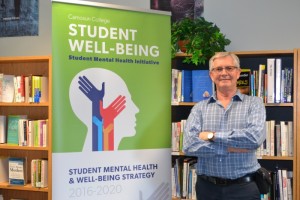On January 28, Camosun College officially launched its new Student Mental Health and Well-being Strategy. The plan is intended to provide a foundation for creating awareness of the mental health and well-being needs of students on campus.
Camosun counsellor Chris Balmer is the leader of the strategy’s development team; he says the plan is a broad and comprehensive approach that involves mental-health services and education for employees and students to promote greater mental-health awareness toward themselves and others.
“We are attempting to grow a culture of compassion amongst the members of the college community, including the students,” says Balmer. “So in that statement, that includes our awareness, our attitude, our ability to exercise tolerance and patience, our awareness of early signs of distress, and our knowledge and ability to respond to people experiencing distress.”
Although there was no specific mention of any department redesign in the strategy, the development team considered all aspects of student interaction with the college and designated specific goals for each of what they consider to be the five categories of operation: policies and practice, environment, literacy support, campus services, and responding to crisis.
“This is progress in development,” says Balmer. “It’s a plan, and with a plan there are many, many conversations still to take place with so many individuals.”

Although there is much work to be done, Balmer expects students to see some change for the better very soon.
“I think it means that within a short period of time students will notice evidence of a renewed awareness and sensitivity to their mental-health experience,” he says.
This sensitive approach to students’ mental health is a far cry from the old view of educational institutions, according to Camosun College Student Society student services coordinator Michael Glover.
“The truth is there are different perspectives on education,” says Glover. “One of them is support and nurture; everybody has to say that now, but the truth is there are still people at this college that believe that they can make you into steel by hammering you, and that is just the old way of thinking.”
Just as educational institutions are changing, so is awareness of mental health. Balmer says that one of the reasons for the creation of this strategy was a meeting that occurred ten years ago at Camosun involving faculty and staff.
“The meeting that took place at Camosun ten years ago brought together faculty and staff from across campus to discuss what we were noticing as more and more students experiencing mental-health challenges and issues on campus,” says Balmer. “We really wanted to make a commitment to see what we could do about that.”
Glover says that he’s interested to see whether or not this strategy will translate into real changes at the college.
“I would be optimistic that there is a commitment to do that; I certainly would hope there would be. Certainly there’s a lot of departments that could really use this awareness.”
He adds that he feels that this is a progressive move, and he hopes it makes a difference at Camosun.
“I would like to see some real, tangible stuff out of it,” he says. “I think that the people that put it together, that was their intent. I think there are people who are interested in it having a real impact.”
